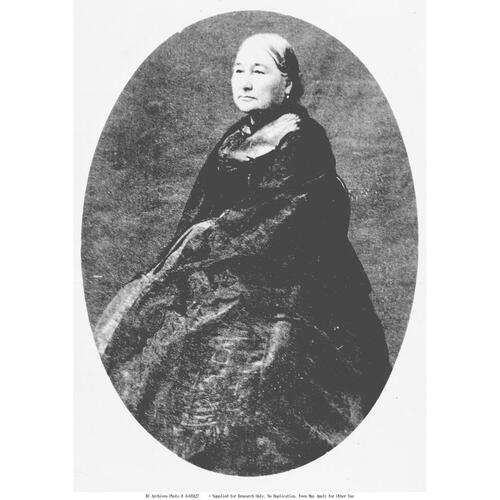
Source: Link
LEGACÉ, JOSETTE (Work), b. c. 1809 near Kettle Falls (Wash.), daughter of Pierre Legacé and a Spokan Indian woman; m. 1825 according to the custom of the country, and formally on 6 Nov. 1849, John Work*, and they had 11 children; d. 30 Jan. 1896 in Victoria, B.C.
Josette Legacé likely grew up in the environs of the fur trade posts along the upper Columbia River. Some time in 1825, when she was about 16, she became the country wife of Hudson’s Bay Company officer John Work, who had recently taken charge of the construction of Fort Colvile (Colville, Wash.). Like many native wives, she soon proved a useful and courageous helpmate. She accompanied her husband on most of his trading expeditions, including those into the difficult Snake River country in the early 1830s. In June 1831, while his party was travelling through what is now Idaho, a third daughter was born to them, two girls having been born at Fort Colvile in 1827 and 1829 respectively. On a later trip, which took Work as far south as California, his wife and young family survived the hazards of the journey but contracted the fever that struck the party on its return. Work was relieved when his family were finally safely housed at Fort Vancouver (Vancouver, Wash.); they continued to live there after Work was given charge of the coasting trade at Fort Simpson (Port Simpson, B.C.) in 1834.
In December 1836, Mrs Work was able to join her husband at their new home in Fort Simpson. Here she cultivated good relations with the Tsimshian women of the area and is credited with introducing them to the rudiments of European-style housekeeping. With her husband she was concerned to moderate the practice of slavery among the northern coastal tribes. Fort Simpson was to be home for the next 12 years, during which three more girls and three boys were born. In the summer of 1841, Mrs Work returned to the Columbia for their two eldest daughters, who had been left there for schooling. Work’s personal correspondence reveals his devotion to and concern for his family and is full of tributes to his wife. As he wrote to his friend Edward Ermatinger*: “The little Wife and I get on very well. She is to me an affectionate partner simple and uninstructed as she is and takes good care of my children & myself.”
During the 1840s Work undertook to educate the children himself, but in 1849 the family moved to Fort Victoria (Victoria), anxious to have the advantage of the new educational opportunities promised by the arrival of Anglican missionaries in the colony. On 6 Nov. 1849, he and his wife had their long-standing country marriage regularized by the Reverend Robert John Staines*. Some time after August 1852, Work purchased a substantial property on the outskirts of Fort Victoria and built a mansion, Hillside, for his family. Their last child was born there in 1854. As the wife of one of the most prominent early landowners in the colony, Mrs Work learned to play the role of a Victorian matron. Her home was noted for its hospitality, one visitor describing the couple as “about the kindest people I ever came across.”
Mrs Work survived her husband, who died in 1861, by 35 years and became the matriarch of a large clan. Six of her daughters married HBC officers or other prominent men in early Victoria. In her lifetime Josette Work saw the city develop rapidly and rendered kindly assistance to incoming pioneer women. When she died in 1896 at the age of 87 she was the oldest known resident of the province and received a special tribute from the British Columbia legislature for her “usefulness in pioneer work and many good deeds.”
PABC, A/B/40/Er/62.4, esp. John Work to Ermatinger, 15 Feb. 1841; Vert. file, Josette Work. C. [W.] Wilson, Mapping the frontier: Charles Wilson’s diary of the survey of the 49th parallel, 1858–1862, while secretary of the British boundary commission, ed. G. F. G. Stanley (Toronto, 1970). Daily Colonist (Victoria), 31 Jan. 1896. N. de B. Lugrin, The pioneer women of Vancouver Island, 1843–1866, ed. John Hosie (Victoria, 1928). Helen Meilleur, A pour of rain: stories from a west coast fort (Victoria, 1980). Sylvia Van Kirk, “Many tender ties”: women in fur-trade society in western Canada, 1670–1870 (Winnipeg, [1980]).
Cite This Article
Sylvia Van Kirk, “LEGACÉ, JOSETTE (Work),” in Dictionary of Canadian Biography, vol. 12, University of Toronto/Université Laval, 2003–, accessed December 22, 2025, https://www.biographi.ca/en/bio/legace_josette_12E.html.
The citation above shows the format for footnotes and endnotes according to the Chicago manual of style (16th edition). Information to be used in other citation formats:
| Permalink: | https://www.biographi.ca/en/bio/legace_josette_12E.html |
| Author of Article: | Sylvia Van Kirk |
| Title of Article: | LEGACÉ, JOSETTE (Work) |
| Publication Name: | Dictionary of Canadian Biography, vol. 12 |
| Publisher: | University of Toronto/Université Laval |
| Year of publication: | 1990 |
| Year of revision: | 1990 |
| Access Date: | December 22, 2025 |




